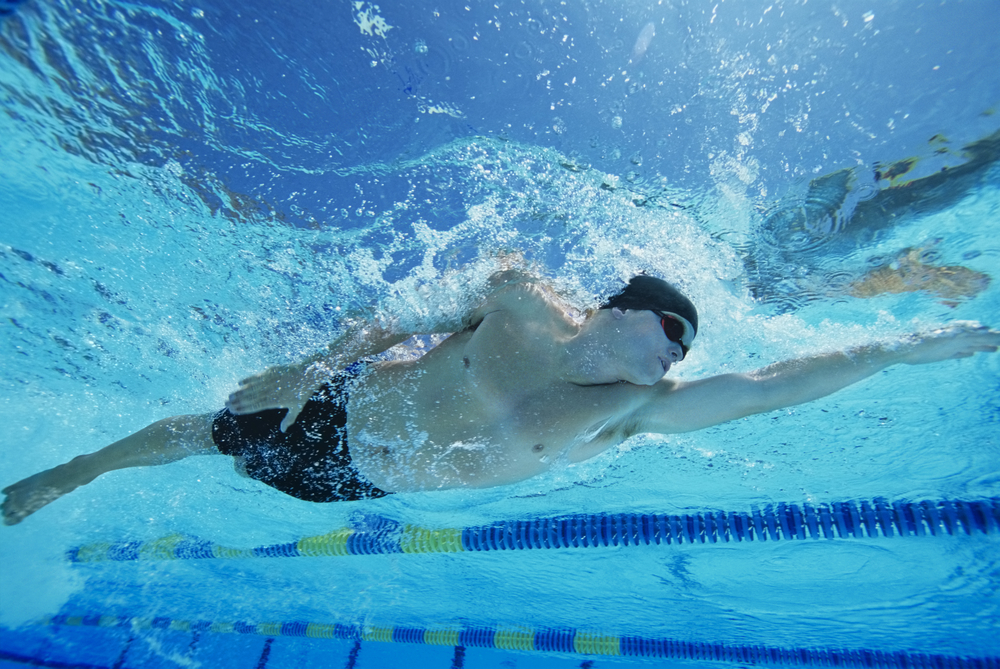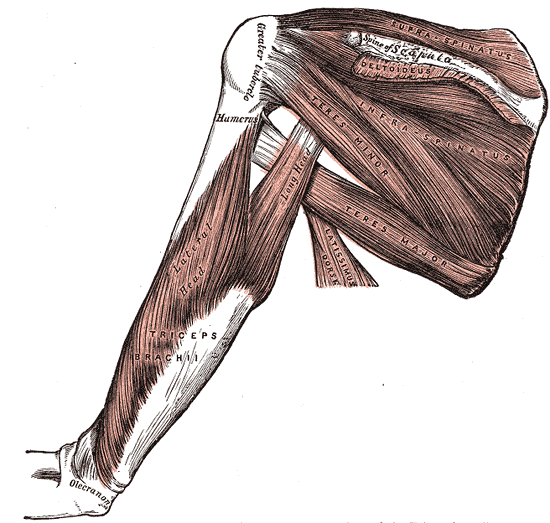
Last time, we talked about how range of motion at the shoulder joint can influence the catch phase of the freestyle swim stroke. I tried to convince you to tailor your swim stroke to what your body is currently capable of, while also committing to regular, continued work on improving your weaknesses. This time around, we’ll go through some techniques to help improve your shoulder mobility.
If you inherit poor posture from your daily working life, you might have discovered some room for improvement in the shoulder flexion assessment from last time. One of the most effective ways to bring about change is to first treat your shoulders to some therapy ball release techniques for shoulder self massage, and then work through range of motion. Try the following approach:
- Release thoracic spine and upper back
- Release external rotators of the shoulder
- Release pectoralis muscles
- Move through range of motion with Shoulder Flossing
There is a method to my madness and a strategy to the sequencing of these exercises for shoulder pain relief. We start with some release for the upper back, between the thoracic spine and scapulae, because tissue quality here plays a key role in motion at the shoulders. Full shoulder motion in all directions can only be accomplished with shoulder blades that move freely along the ribcage. If thoracic extension is limited and you have gummy tissue around your shoulder blades, your scapulae won’t move without compensation. We want to free this area up a bit first thing because our subsequent release techniques will continue to incorporate movement at the shoulder in various directions.
Next on our list is to address the external rotators of the shoulder. The external portion of the rotator cuff consists of the infraspinatus, supraspinatus, and teres minor. Like the muscles of the upper back, these are usually laden with adhesions and trigger points, and they are often overstretched from slumping with rounded shoulders. With this in mind, we don’t want to stretch our external rotators more, we just want to improve tissue quality.
Our final ball stop is for the front of the shoulder and the pectoralis muscles. We will be calling upon shoulder movement in all planes with our technique here. This work could be restricted if we didn’t go through the previous release techniques to get the scapulae moving more freely.
Our grand finale is to take our released tissues through some dynamic movement to explore range of motion. The goal isn’t necessarily to stretch a particular muscle, but to open the shoulders into new positions that allow a freer movement pattern. Improved range of motion can make your chosen recreational activities and exercises smoother and easier to perform. This won’t happen overnight, but a regular routine will pay dividends over time. Check out the video lineup below, follow along, and remember to maintain consistency as the weeks and months go by.













As a swimmer I clearly need to be doing these exercises prior to swimming. Thanks you for putting this series together. My stroke also thanks you.
Love the sequencing and rationale behind these shoulder movements!
As a swim coach and swimmer myself, I am always searching for good ways to mobilize and strengthen the shoulders. I am so excited to start incorporating shoulder flossing into my athletes regime.
This makes me even more passionate about using the YTU balls! They are such an amazing tool to have to help our bodies move and feel better.
I wouldn’t connect automatically YTU balls with swimming technique – but it makes all sense. Thank you!
As a master’s swimmer, I really appreciate the sequencing of this Therapy Ball work. I suffer from tightness in my left shoulder and it rears it head during backstroke and butterfly…..Going to try this sequence prior to a swim….Thanks
This was a well rounded blog with instruction and video to show how to move around the totality of the shoulder joint, from anterior to posterior, not prioritizing any muscle group more than another. This self care can be used for way more than swimming as too often we lead lives not using our full range of motion in this joint. I especially liked how the one video was done outdoors, basically not in any structured environment. Therapy balls on the run!!
Super to see that with some exercises, the body is set up and releases its tension allowing greater range of motion in all directions, !!!
very interesting I still learned a lot with this article
LinkedIn interesting with swimming thanks
Thanks for the great shoulder pointers. I just saw an orthopedic surgeon for shoulder pain and to review a small shoulder labral tear. He said I was not a surgical candidate and just needed to strengthen my external rotators and work on more balanced tension in the muscles of my shoulders. This will be a great shoulder tune-up for me.
Very thoughtful sequencing, especially doing thoracic release in the beginning. Wish I knew about these when I was swimming in high school. And good highlight on release in the pecs for shoulder mobility.
Thank you for this. I just started my level 1 certification and this article has helped me create contextual understanding of some of the work we did with shoulders today, especially in circumnavigation. I also work with baseball players who often get shoulder injuries from aggressive wind ups and will try to incorporate this in my work with them!
Love watching these videos! My daughter is a collegiate swimmer and I passed them along to her!! Great information and I look forward to trying them myself!
Love this specific work addressing the shoulders for not just swimmers, but any of my clients who work at desks all day and have the dreaded rounded shoulders and tight pecs! Looking forward to putting this into practice with them. Thank you!
I really enjoyed your method to opening up stuck tissue in the front and back of the shoulder joint specifically at the rotator cuff. I am wondering if adding activation exercises such as an lat pulling motion after going through the exploratory movement would be beneficial. As well as doing any more internal and external rotation exercises with the shoulder to train that movement. Great post!
I haven’t been an active swimmer since I was a kid, but I did once have dreams of swimming in the Olympics and winning a gold medal. And while I did not actively pursue this sport the mobility and strength of the shoulder is absolutely relevant to everyday life.
I have many clients that are not able to move their arms with full range of motion and without feeling pain. I also have many breast cancer survivors who have literally been told by their doctors that they should just be happy that they are alive and cancer “free.”
Personally, I think that is a horrible way to treat a patient and a completely toxic attitude that negates the experience of the survivor.
Receptivity as a theme, whether it’s the shoulders or otherwise really speaks to me. I loved day 1 when Jill said that she doesn’t assume that she knows everything and she is still constantly learning, growing and challenging herself. After all that is what life is really about, pushing our boundaries, increasing range of motion…putting yourself out there.
Thank you Mandy!
This is full of helpful information. I especially like the diagram of the muscles weaving around the shoulder joint and the reminders of Flossing Variation 2 technique in the video. I also like the way the video for infraspinatus guided the viewer to find it and then demonstrated the various ball techniques.
Thank you for the excellent article. I have several clients who swim and practice yoga and I appreciate your language on the importance of “improving tissue quality” through the application of therapy balls vs. “more stretching.” Brilliant! I will be sharing your article with them. I also appreciate having all of the video links and great anatomy illustrations included in your article. Grateful for your extra efforts!
I’ll be using these ball rolling techniques as I get ready for the upcoming Triathlon season and will be swimming on a regular basis. Thanks for a great article and very useful techniques. Looking forward to seeing some improvement in my swim stroke this year or at the very least relief in my shoulder area and increased mobility due to the repetitive movements of swimming. Thank you, Mandy. I’ll be referring back to this blog frequently.
Great information! Agreed that we need to focus more on the upper thoracic vis-a-vis shoulder mobility. We can’t succumb to modern lifestyle’s predisposition for kyphosis. Moreover, the lumbar spine gets too much press. We can all benefit from redirecting our quest for greater mobility by focusing on the thoracic spine.
Mandy, what a great article! My take away is to remember that with ball therapy I don’t want to stretch external rotators I want to increase tissue quality!
Reading this post made me immediately think of my brother in law who competed in Rio at the summer Olympics for Swimming. The intense training regiment he went through to train for the Olympics noticeably worsened his posture. He has been a competitive swimmer for a long time, however it seemed to be extra bad in preparation for the Olympics. After reading this article I feel all of the time he spent in spinal flexion would have majorly changed his posture. Looking at this now I would have recommended to prioritize releasing the thoracic spine and upper back. The excessive protraction in swimming from trying to lengthen each stroke leaves the swimmer in a shoulder protraction in every day life.
My body agrees with your shoulder approach. My thoracic spine do not have a big range of the extension. My bone limit my muscle to go the full range of stretch on the muscles. Only way I can release some part of my spine is from either manual release or self massage release with the yoga tune up therapy ball. I did overdo my yoga pose to get more range on my shoulder and end up I calcify my soft tissues instead. My range of motion decrease even more after the overuse approach to my shoulder. From then, I start to try different approach to my poor shoulder and upper back. I need to take care my shoulders in all different directions. I need to take care all different muscles that attach to my shoulder blades, clavicle and humurs, including all rotation cuff muscles, and serrates anterior, levator scapula, upper trapezius, triceps brahii, biceps brachii, teres minor, teres major, latimisse dorse, coracobrachialis, pectoralis minor and major…with the ball. I know it sounds like a lot but if I don’t roll like this way, my tendon of the long head of the biceps will snap when I do any circumduction.